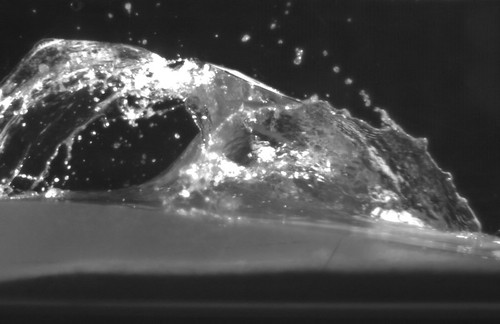Some cool high tech images:
Indrasenan Thusyanthan – ‘Tsunami wave impact on a typical Sri Lankan costal house’

Image by Engineering at Cambridge
Dr Gopal Madabhushi and Dr I. Thusyanthan at the Department of Engineering Cambridge University are testing a house design that researchers from Massachusetts Institute of Technology (MIT), Harvard University Architecture Department and the engineering design company Buro Happold have designed with the aim that it will have a good chance of withstanding a tsunami wave. Dubbed the Tsunami-safe(r) house, their model for a Sri Lankan house is a unique combination of high-tech design and low-tech assembly that would allow waves to wash through it rather than knocking it flat. A house that can be built at around the cost of current house build costs in Sri Lanka and from readily available materials.
Gopal and his team have created a scale model (1/25th) of the prototype house which has been tested in a large glass tank in which the near shore tsunami wave conditions have been created. The tsunami wave is created by dropping a heavy weight (~100 kg) into the water at the deepest end of the tank. The sudden displacement of water in the deep end of the tank creates the wave and the wave propagates to the shore where the model house has been placed. Instead of four solid walls, the new house design has four core columns made of concrete reinforced with metal rods about three meters wide. Walls of wood or bamboo are built in between the columns. The main aim of the design is the survival of the structure against a tsunami wave, thus the occupants still needs to be evacuated to safety prior to a tsunami. A scale model of a typical costal Sri Lankan house was also tested in the wave tank to show the tsunami wave induced damage to those houses.
A high speed (1000 frames/s) video camera is used to capture the tsunami wave as it hits and propagates past the model house. The video stills showing how the water travels through the scale model of the prototype house can be seen in the powerpoint presentation available for download at www.eng.cam.ac.uk/news/stories/2006/tsunami/ Miniature pressure sensors fixed to the walls of the building facing the wave front provides pressure exerted by the tsunami wave on the building walls. Pore pressure sensors set in the sand provides the data to calculate the speed and height of the wave as the wave passes over them. Sensors like these are currently being placed in the Indian Ocean off the coast of Sri Lanka in the hope that they will give a 1 to 2 hour warning of another tsunami. An early warning system using cellphones is also being designed by the University of Moratuwa in Sri Lanka.
www.eng.cam.ac.uk/news/stories/2010/ICE_Bill_Curtin_Prize/
Indrasenan Thusyanthan – ‘Tsunami wave impact on a typical Sri Lankan costal house’

Image by Engineering at Cambridge
Dr Gopal Madabhushi and Dr I. Thusyanthan at the Department of Engineering Cambridge University are testing a house design that researchers from Massachusetts Institute of Technology (MIT), Harvard University Architecture Department and the engineering design company Buro Happold have designed with the aim that it will have a good chance of withstanding a tsunami wave. Dubbed the Tsunami-safe(r) house, their model for a Sri Lankan house is a unique combination of high-tech design and low-tech assembly that would allow waves to wash through it rather than knocking it flat. A house that can be built at around the cost of current house build costs in Sri Lanka and from readily available materials.
Gopal and his team have created a scale model (1/25th) of the prototype house which has been tested in a large glass tank in which the near shore tsunami wave conditions have been created. The tsunami wave is created by dropping a heavy weight (~100 kg) into the water at the deepest end of the tank. The sudden displacement of water in the deep end of the tank creates the wave and the wave propagates to the shore where the model house has been placed. Instead of four solid walls, the new house design has four core columns made of concrete reinforced with metal rods about three meters wide. Walls of wood or bamboo are built in between the columns. The main aim of the design is the survival of the structure against a tsunami wave, thus the occupants still needs to be evacuated to safety prior to a tsunami. A scale model of a typical costal Sri Lankan house was also tested in the wave tank to show the tsunami wave induced damage to those houses.
A high speed (1000 frames/s) video camera is used to capture the tsunami wave as it hits and propagates past the model house. The video stills showing how the water travels through the scale model of the prototype house can be seen in the powerpoint presentation available for download at www.eng.cam.ac.uk/news/stories/2006/tsunami/ Miniature pressure sensors fixed to the walls of the building facing the wave front provides pressure exerted by the tsunami wave on the building walls. Pore pressure sensors set in the sand provides the data to calculate the speed and height of the wave as the wave passes over them. Sensors like these are currently being placed in the Indian Ocean off the coast of Sri Lanka in the hope that they will give a 1 to 2 hour warning of another tsunami. An early warning system using cellphones is also being designed by the University of Moratuwa in Sri Lanka.
www.eng.cam.ac.uk/news/stories/2010/ICE_Bill_Curtin_Prize/

Poster un Commentaire